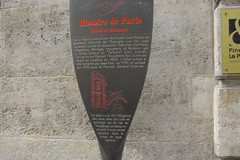Dr Gui Patin


Dr Gui Patin
(1601-1672)
Commemorated on 1 plaque
Hôtel de Montmor Dans l'hôtel construit en 1623 pour Jean Habert de Montmor, trésorier de l'Epargne, son fils Louis recevait, autour de Gassendi, Roberval, Gui Patin, Chapelain, Ménage, Huygens et Molière, qui y donna lecture du "Tartuffe" alors interdit. Ce cercle préfigurait l'Academie des Sciences avant sa création en 1666. L'hôtel actuel a été remanié par deux fois: en 1737, et surtout en 1752 pour le Fermier Général Charron. De style Louis XV, l'élégance des deux ailes sur cour se prolonge sur la rue du Temple par un retour en arrondi. Il reste un bel escalier dans le corps de logis central.
English translation: Hotel de Montmor In the hotel built in 1623 for Jean Habert de Montmor, treasurer of the Epargne, his son Louis received, around Gassendi, Roberval, Gui Patin, Chapelain, Housekeeping, Huygens and Molière, who read the “Tartuffe” then forbidden. This circle prefigured the Academie des Sciences before its creation in 1666. The present hotel was redesigned twice: in 1737, and especially in 1752 for the farmer General Charron. Louis XV style, the elegance of the two wings on the courtyard extends on the street of the Temple by a round return. There's still a nice staircase in the central housing body. [AWS Translate]
79, Rue du Temple, 3rd arrondissement, Paris, France where they visited

